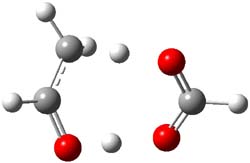Mosey has a nice follow-up study on the origin of Woodward-Hoffman forbidden ring opening of cyclobutene under mechanical stress.1 (See this blog post discussing the earlier work of Martinez.2) Pulling on cis substituents of a cyclobutene causes the ring to open in a disrotatory fashion. Normally, the WH forbidden pathway is accessed by photolysis which creates a new electronic state. Mosey asks if this same mechanism is occurring during mechanical stress.
On the face of things, this seems unlikely; how can a mechanical force lead to a new electronic state? CASSCF computations with either no applied external force or with varying sized external forces and IRC computations help answer this question. Without an external force, a diradical (or at least a species with high diradical character – and this could be the transition state) is found along the disrotatory pathway. This same diradical is found regardless of the size of the externally applied mechanical force. What does change is the position of the TS along the pathway: as the force increases, the TS becomes earlier, and the reaction barrier diminishes. No change in the electronic state is affected by the applied mechanical stress.
References
(1) Kochhar, G. S.; Bailey, A.; Mosey, N. J., "Competition between Orbitals and Stress in Mechanochemistry," Angew. Chem. Int. Ed., 2010, 49, 7452-7455, DOI: 10.1002/anie.201003978
(2) Ong, M. T.; Leiding, J.; Tao, H.; Virshup, A. M.; Martinez, T. J., "First Principles Dynamics and Minimum Energy Pathways for Mechanochemical Ring Opening of Cyclobutene," J. Am. Chem. Soc., 2009, 131, 6377-6379, DOI: 10.1021/ja8095834


